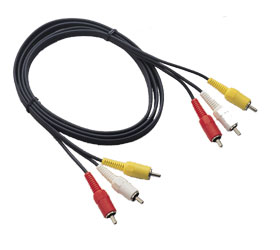Composite Video Cables
Composite cables are the next step up in performance from coaxial cable, at least RF coaxial cable. The composite cables use RCA connectors to make the connections between home theater components. It is for this reason that they are often referred to as RCA cables.
How Composite Cables Work
Unlike coaxial cables which send all video and audio information in the same signal, composite cables divide the information into three categories: video, audio right, and audio left. These categories are essentially self-explanatory. The video cable carries all information pertaining to video;
this information being color and luminescence or
brightness. The video portion of the composite cable is
denoted by yellow on the RCA connector. This color
arrangement is a standard in the home theater industry.
video;
this information being color and luminescence or
brightness. The video portion of the composite cable is
denoted by yellow on the RCA connector. This color
arrangement is a standard in the home theater industry.The audio portion of the signal is split into audio right and audio left as previously mentioned. The colors are also a standard by which the entire home theater industry follows; red is audio right and white is audio left. By separating the two, the audio from a source is capable of being presented in stereo sound.